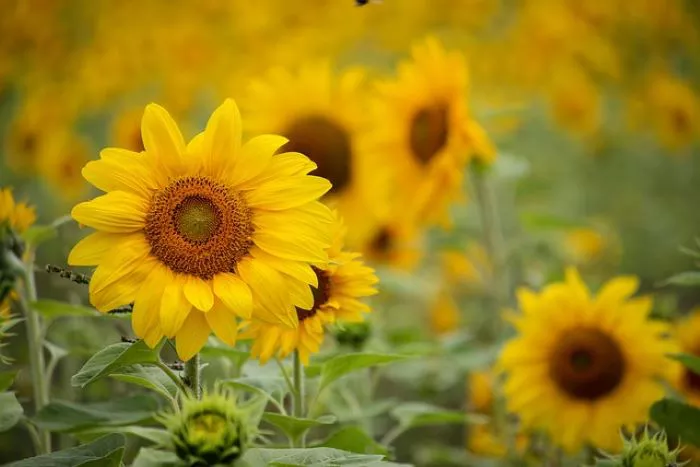Sunflowers are not only admired for their striking appearance but also for their ability to attract a variety of wildlife. These vibrant flowers play a significant role in ecosystems, serving as a food source and habitat for many species. Understanding what sunflowers attract can help gardeners and nature enthusiasts appreciate their ecological importance and enhance biodiversity in their gardens. This article will explore the various creatures that sunflowers attract, including insects, birds, and other wildlife.
The Importance of Sunflowers in Ecosystems
Sunflowers belong to the Asteraceae family and are native to North America. They are known for their tall stalks and large, bright yellow blooms. These flowers are not only visually appealing but also serve vital ecological functions. Sunflowers are excellent sources of nectar and pollen, making them attractive to many pollinators. Additionally, their seeds are rich in nutrients, drawing in birds and other wildlife.
By planting sunflowers, gardeners can create a welcoming environment for various species. This not only enhances the beauty of the landscape but also supports local ecosystems.
Pollinators and Insects
One of the primary groups attracted to sunflowers is pollinators. These include bees, butterflies, and other insects that play a crucial role in plant reproduction.
Bees: Sunflowers are particularly attractive to bees, including honeybees and native bee species. The large flower heads provide abundant nectar and pollen, which are essential food sources for these pollinators. Bees help in the pollination process, allowing sunflowers to produce seeds.
Butterflies: Sunflowers also attract various butterfly species. The bright colors of the flowers serve as a beacon for butterflies seeking nectar. Common visitors include monarchs and swallowtails, which contribute to the pollination of sunflowers and other nearby plants.
Other Insects: In addition to bees and butterflies, sunflowers attract a range of other insects. Ladybugs, lacewings, and hoverflies are often seen on sunflowers. These insects help control pest populations in the garden, making sunflowers beneficial for overall plant health.
Birds and Seed Eaters
Once sunflowers bloom and develop seeds, they become a significant food source for birds. The large, seed-filled heads of sunflowers are particularly appealing to many avian species.
Finches: Goldfinches are among the most common birds attracted to sunflowers. They are known for their acrobatic feeding habits and can often be seen hanging upside down to access the seeds. Sunflower seeds provide essential fats and proteins for these birds, especially during the breeding season.
Sparrows: Various sparrow species also enjoy sunflower seeds. They forage on the ground beneath sunflower plants, searching for fallen seeds. This behavior helps in seed dispersal, allowing new sunflowers to grow in different areas.
Other Birds: In addition to finches and sparrows, sunflowers attract a wide range of other birds, including chickadees, jays, and doves. These birds benefit from the seeds and contribute to the ecological balance by dispersing seeds and pollinating plants.
Mammals and Other Wildlife
Sunflowers do not only attract insects and birds. They also draw the attention of various mammals and other wildlife.
Squirrels: Squirrels are known for their love of sunflower seeds. They often climb the plants to access the seeds directly from the flower heads. This behavior can sometimes lead to damage to the plants, but it also contributes to the natural cycle of seed dispersal.
Deer: In some regions, deer may be attracted to sunflowers, especially young plants. While they primarily feed on the leaves and stems, they can impact the growth of sunflowers in gardens and fields.
Rabbits: Rabbits are also known to nibble on sunflower leaves and stems. While they may not be as significant as birds or insects in terms of attraction, their presence can still affect sunflower growth.
Creating a Pollinator-Friendly Garden
To maximize the benefits of sunflowers and attract even more wildlife, gardeners can take specific steps to create a pollinator-friendly environment.
Plant Diversity: Incorporating a variety of flowering plants alongside sunflowers can attract a broader range of pollinators. Consider planting other native flowers that bloom at different times throughout the growing season.
Avoid Pesticides: Reducing or eliminating pesticide use can help protect beneficial insects and pollinators. Organic gardening practices promote a healthier ecosystem and attract more wildlife.
Provide Shelter: Creating habitats for birds and beneficial insects can enhance the attractiveness of your garden. Consider adding birdhouses, native shrubs, and other plants that provide shelter and nesting sites.
Conclusion
Sunflowers are more than just beautiful flowers; they are vital components of local ecosystems. By attracting a diverse array of pollinators, birds, and other wildlife, sunflowers play a crucial role in supporting biodiversity. Understanding what sunflowers attract can help gardeners create more vibrant and sustainable landscapes. By planting sunflowers and fostering a welcoming environment for wildlife, we can contribute to the health of our ecosystems while enjoying the beauty and benefits of these remarkable plants.


